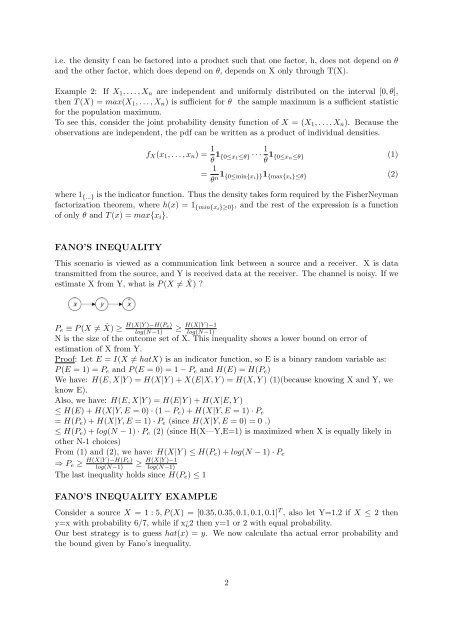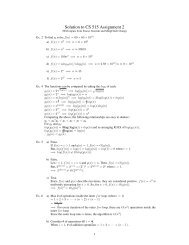Scribe 9 - Classes
Scribe 9 - Classes
Scribe 9 - Classes
You also want an ePaper? Increase the reach of your titles
YUMPU automatically turns print PDFs into web optimized ePapers that Google loves.
i.e. the density f can be factored into a product such that one factor, h, does not depend on θ<br />
and the other factor, which does depend on θ, depends on X only through T(X).<br />
Example 2: If X 1 , . . . , X n are independent and uniformly distributed on the interval [0, θ],<br />
then T (X) = max(X 1 , . . . , X n ) is sufficient for θ the sample maximum is a sufficient statistic<br />
for the population maximum.<br />
To see this, consider the joint probability density function of X = (X 1 , . . . , X n ). Because the<br />
observations are independent, the pdf can be written as a product of individual densities.<br />
f X (x 1 , . . . , x n ) = 1 θ 1 {0≤x 1 ≤θ} · · · 1<br />
θ 1 {0≤x n≤θ} (1)<br />
= 1<br />
θ n 1 {0≤min{x i }}1 {max{xi }≤θ} (2)<br />
where 1 {...} is the indicator function. Thus the density takes form required by the FisherNeyman<br />
factorization theorem, where h(x) = 1 {min{xi }≥0}, and the rest of the expression is a function<br />
of only θ and T (x) = max{x i }.<br />
FANO’S INEQUALITY<br />
This scenario is viewed as a communication link between a source and a receiver. X is data<br />
transmitted from the source, and Y is received data at the receiver. The channel is noisy. If we<br />
estimate X from Y, what is P (X ≠ ˆX) ?<br />
H(X|Y )−H(Pe)<br />
log(N−1)<br />
≥<br />
H(X|Y )−1<br />
log(N−1)<br />
P e ≡ P (X ≠ ˆX) ≥<br />
N is the size of the outcome set of X. This inequality shows a lower bound on error of<br />
estimation of X from Y.<br />
Proof: Let E = I(X ≠ hatX) is an indicator function, so E is a binary random variable as:<br />
P (E = 1) = P e and P (E = 0) = 1 − P e and H(E) = H(P e )<br />
We have: H(E, X|Y ) = H(X|Y ) + X(E|X, Y ) = H(X, Y ) (1)(because knowing X and Y, we<br />
know E).<br />
Also, we have: H(E, X|Y ) = H(E|Y ) + H(X|E, Y )<br />
≤ H(E) + H(X|Y, E = 0) · (1 − P e ) + H(X|Y, E = 1) · P e<br />
= H(P e ) + H(X|Y, E = 1) · P e (since H(X|Y, E = 0) = 0 .)<br />
≤ H(P e ) + log(N − 1) · P e (2) (since H(X—Y,E=1) is maximized when X is equally likely in<br />
other N-1 choices)<br />
From (1) and (2), we have: H(X|Y ) ≤ H(P e ) + log(N − 1) · P e<br />
H(X|Y )−H(Pe)<br />
H(X|Y )−1<br />
log(N−1)<br />
⇒ P e ≥<br />
log(N−1)<br />
≥<br />
The last inequality holds since H(P e ) ≤ 1<br />
FANO’S INEQUALITY EXAMPLE<br />
Consider a source X = 1 : 5, P (X) = [0.35, 0.35, 0.1, 0.1, 0.1] T , also let Y=1,2 if X ≤ 2 then<br />
y=x with probability 6/7, while if x¿2 then y=1 or 2 with equal probability.<br />
Our best strategy is to guess hat(x) = y. We now calculate tha actual error probability and<br />
the bound given by Fano’s inequality.<br />
2

















